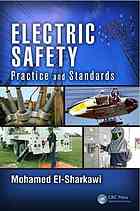

Most ebook files are in PDF format, so you can easily read them using various software such as Foxit Reader or directly on the Google Chrome browser.
Some ebook files are released by publishers in other formats such as .awz, .mobi, .epub, .fb2, etc. You may need to install specific software to read these formats on mobile/PC, such as Calibre.
Please read the tutorial at this link: https://ebookbell.com/faq
We offer FREE conversion to the popular formats you request; however, this may take some time. Therefore, right after payment, please email us, and we will try to provide the service as quickly as possible.
For some exceptional file formats or broken links (if any), please refrain from opening any disputes. Instead, email us first, and we will try to assist within a maximum of 6 hours.
EbookBell Team

4.4
72 reviewsElectric power engineering education traditionally covers safety of the power equipment and systems. Little attention, if any, is given to the safety of people. When they reach professional status, most power engineers are not familiar with electric safety issues such as practices governing site works or grounding techniques of dwellings, hospitals, and factories. Designed for both electrical engineering student and practicing power engineers, Electric Safety: Practice and Standards provides the knowledge and analysis they need to be well versed in electric safety. Features:Includes techniques to assess safety practices at worksites and provides remedies to correct safety problemsAddresses the elusive stray voltage problem and provides techniques to mitigate its impact in dwellings as well as in sensitive installations such as hospitals and dairy farmsProvides approximate, yet accurate, analyses and techniques that can be used to assess electric safety without the need for extensive computation or elaborate programsIncludes several case studies from real events and examples demonstrating how variations in electric safety procedure implementation influence safety levelsBased on the authors' years of experience as an expert witness and electric safety training instructor, the book covers the analysis of electric safety practices as well as the interpretations of various safety codes. Including homework problems and a solutions manual, this book is a comprehensive guide to recognize and eliminate hazards of electric shocks for professionals working on electric power equipment, as well as people such as the general public in commonly used places, farms workers and animals, and hospital patients.
Electric power engineering education traditionally covers safety of the power equipment and systems. Little attention, if any, is given to the safety of people. When they reach professional status, most power engineers are not familiar with electric safety issues such as practices governing site works or grounding techniques of dwellings, hospitals, and factories. Designed for both electrical engineering student and practicing power engineers, Electric Safety: Practice and Standards provides the knowledge and analysis they need to be well versed in electric safety. Features:Includes techniques to assess safety practices at worksites and provides remedies to correct safety problemsAddresses the elusive stray voltage problem and provides techniques to mitigate its impact in dwellings as well as in sensitive installations such as hospitals and dairy farmsProvides approximate, yet accurate, analyses and techniques that can be used to assess electric safety without the need for extensive computation or elaborate programsIncludes several case studies from real events and examples demonstrating how variations in electric safety procedure implementation influence safety levelsBased on the authors' years of experience as an expert witness and electric safety training instructor, the book covers the analysis of electric safety practices as well as the interpretations of various safety codes. Including homework problems and a solutions manual, this book is a comprehensive guide to recognize and eliminate hazards of electric shocks for professionals working on electric power equipment, as well as people such as the general public in commonly used places, farms workers and animals, and hospital patients